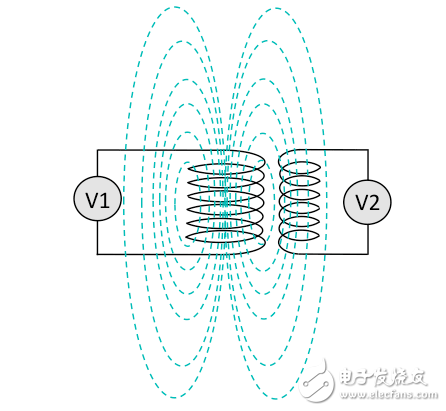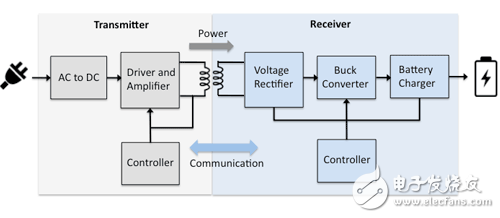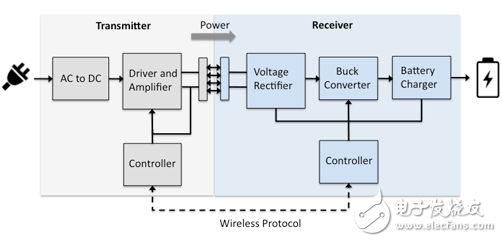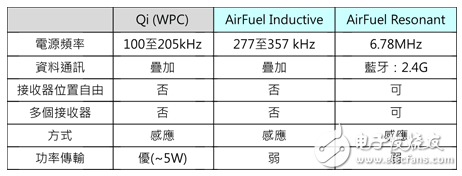The advantages of wireless charging for portable devices go far beyond the shackles of cables. As early as 2013, smart phone manufacturers began to integrate wireless charging in their smartphones. In the future, the wireless charging function of mobile devices is expected to be as popular as Wi-Fi and Bluetooth.
In June 2015, the Alliance for Wireless Power (A4WP) and the Power Matters Alliance (PMA) merged to form the AirFuel Alliance. This merger has accelerated the vision of future consumers, where devices will be interoperable and convenient.
Near field inductive charging
Nikola Tesla first demonstrated near-field or magnetic resonance charging in the 1880s, transmitting energy through an oscillating magnetic field (Fig. 1).

Figure 1 shows the magnetic resonance diagram
The current and voltage delivered from the transmitter to the receiver must be alternating current. A charging pad that acts as a transmitter draws power from a wall outlet, steps down the AC grid voltage and converts it to DC, providing bias to the transmitter's driver and controller circuitry. The driver and controller generate a switching signal and can adjust the switching frequency to convert the direct current into alternating current and input it to the primary side coil.
On the receiver side, the AC power is rectified and adjusted by synchronous switching to charge the battery. The frequency in the coil changes depending on the amount of power required by the receiver. The communication signal is superimposed on the power signal, so both know that the device has been placed on the charging pad. Inductive charging is more efficient, but it is very sensitive to whether the coil is aligned. The coupling coil needs to be adjusted to slightly deviate from the resonant frequency to optimize power transfer (Figure 2).

Figure 2 Near-field inductive charging system
The Qi developed by the Wireless Power ConsorTIum (WPC) is one of the mainstream near-field wireless charging standards, and the community includes more than 200 companies. AirFuel proximity magnetic induction (InducTIve) is another standard. Powermat is a good example of bridging technology that provides a universal ring that can be used with a charging pad to charge a portable device.
Near field resonance charging
Resonance charging is another form of near-field charging that works the same as an electromagnetic field, but requires a front end of the resonator (Figure 3). The standard is dominated by AirFuel Resonant, allowing for a shorter distance between the transmitter and receiver. A single 6.78MHz transmitter can support multiple receivers without physical alignment. However, strict frequency matching is required between the receiver and the transmitter to maximize the power transmission distance at a particular coil size. As the number of connected devices increases and the distance increases, the transmission power decreases. A separate two-way channel is required between the transmitter and each receiver, usually by Bluetooth.

Figure 3 Near Field Resonance Charging System
Table 1 is a comparison table of three near-field charging standards for Qi, AirFuel InducTIve and AirFuel Resonant. It is worth noting that whether it is electromagnetic induction or resonant charging, the transmitter and receiver must be kept at the shortest distance.

Table 1 Comparison of near-field charging standards
Due to two standards, General Motors (GM) announced that its vehicles will support both the AirFuel InducTIve and Qi standards. Samsung also decided that its phone will support two standards.
AC power supply is a kind of power supply that converts the input mains or DC input into a pure sine wave output after AC-DC-AC or DC-AC conversion. The ideal AC power supply is characterized by stable frequency, stable voltage, zero internal resistance and pure sine wave output voltage wave (without distortion). Mainly used for power grid simulation tests conducted by various electrical appliance manufacturers on electrical appliances according to the voltage/frequency requirements of different countries, various AC motors, AC transformers, aircraft & mechanical equipment and other electronic devices that require pure, regulated and frequency-stabilized output.
Our AC power supply mainly includes three types
1. AC Power Supplies converting the input mains AC by AC-DC-AC, output voltage and frequency are stable and adjustable with pure sine wave output waveform, so called: Variable Frequency AC Power Supplies.
2. AC Power Supplies converting the DC output of the battery and other DC equipment by DC-AC, giving an AC sinusoidal output with stable output voltage and frequency. so called: Inversion AC Power Supplies.
3. AC Power Supplies converting the input mains AC by AC-DC-AC, giving a variable voltage AC output at constant 400Hz output frequency ultra-high output frequency stability. so called: Intermediate Frequency AC Power Supplies.
4. According to the difference in the number of output phases, the AC Power Supplies can be divided into single-phase output AC power supplies and three-phase output AC power supplies.
Different from Variac and AC voltage regulators, our AC power supplies support the setting of output voltage and frequency and has superior high precision, high stability, and high efficiency stable frequency AC output, not only for AC power conversion but also for AC high precision test purpose.
Through the friendly operation panel, you can read the output data such as output voltage, output current, output power, power factor, etc., providing accurate data records for your test, and can add RS485 interfaces as standard, following the MODBUS-RTU international communication protocol, which can realize remote control and operating status monitoring of the power supplies.
Our AC Power Supplies have comprehensive protection functions, such as: over voltage, over current, over temperature and short circuit protections, which can protect the AC power supplies and DUT from damages.
AC Power Sources, AC Sources, AC - AC Power Supplies, DC - AC Power Supplies, AC Switching Power Supplies
Yangzhou IdealTek Electronics Co., Ltd. , https://www.idealtekpower.com